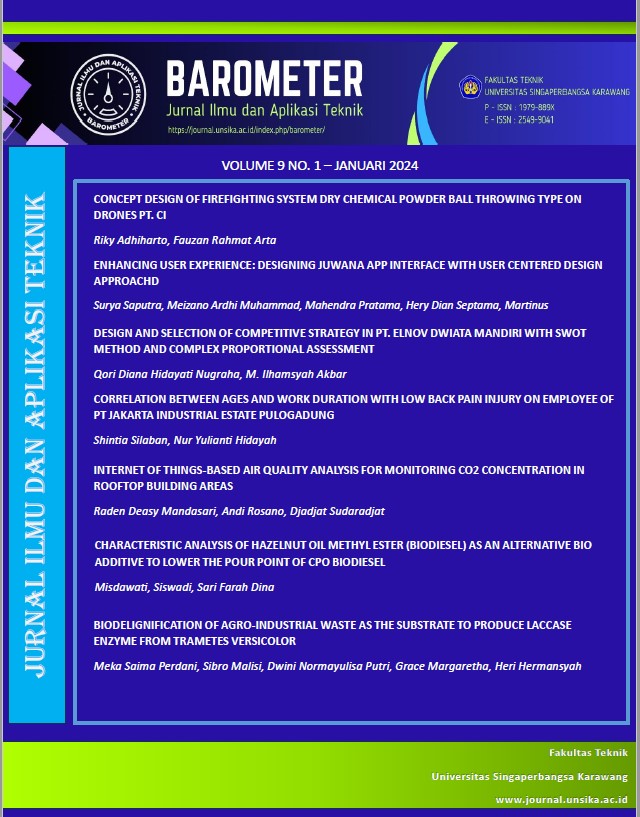INTERNET OF THINGS-BASED AIR QUALITY ANALYSIS FOR MONITORING CO2 CONCENTRATION IN ROOFTOP BUILDING AREAS
DOI:
https://doi.org/10.35261/barometer.v9i1.10447Abstract
This research aims to comprehend the air quality in rooftop areas in the city of DKI Jakarta, renowned for its high population density and rapid infrastructure development. The main focus is on the concentration of carbon dioxide (CO2) in the roof area, serving as an indicator of air quality influenced by air pollution, industrial activity, and heavy transportation. The utilization of Internet of Things (IoT) technology and CO2 sensors proves to be an effective solution for real-time monitoring of CO2 concentrations. This research holds significance for air pollution control measures, providing insight into the impact of rooftop gardens in reducing CO2 emissions and inspiring future research in the realms of air quality and IoT technology. Through prior literature, three notable studies underscore the industrial and technological impact of CO2 monitoring. The research was conducted in two locations in DKI Jakarta, namely the Garden Roof and Ordinary Roof areas. Monitoring took place over four parts of the day with a four-hour interval to compare CO2 levels. The tools employed included the NodeMCU ESP8266, DHT-22 sensor, and MQ-135 sensor. Results revealed that roof areas with gardens exhibited lower average CO2 levels (295 PPM) compared to regular roofs (360 PPM), indicating the potential of garden roof designs to reduce CO2 concentrations. Research recommendations include increasing the frequency of data collection and considering additional factors for a more comprehensive understanding of urban air quality.
Downloads
References
S. Dhingra, R. B. Madda, A. H. Gandomi, R. Patan, and M. Daneshmand, “Internet of things mobile-air pollution monitoring system (IoT-Mobair),” IEEE Internet Things J., vol. 6, no. 3, pp. 5577–5584, 2019.
J. Huang et al., “A crowdsource-based sensing system for monitoring fine-grained air quality in urban environments,” IEEE Internet Things J., vol. 6, no. 2, pp. 3240–3247, 2019.
D. Kim, S. Cho, L. Tamil, D. J. Song, and S. Seo, “Predicting asthma attacks: Effects of indoor PM concentrations on peak expiratory flow rates of asthmatic children,” IEEE Access, vol. 8, pp. 8791–8797, 2020.
D. Despa, N. Amaro, M. A. Muhammad, G. F. Nama, and Y. Martin, “Dashboard Pengawasan Besaran Listrik Waktu Nyata,” Barometer, vol. 4, no. 1, pp. 151–154, 2019.
Q. Han, P. Liu, H. Zhang, and Z. Cai, “A Wireless Sensor Network for Monitoring Environmental Quality in the Manufacturing Industry,” IEEE Access, vol. 7, pp. 78108–78119, 2019.
L. Zhao, W. Wu, and S. Li, “Design and Implementation of an IoT-Based Indoor Air Quality Detector With Multiple Communication Interfaces,” IEEE Internet Things J., vol. 6, no. 6, pp. 9621–9632, 2019.
D. Zhang and S. S. Woo, “Real Time Localized Air Quality Monitoring and Prediction through Mobile and Fixed IoT Sensing Network,” IEEE Access, vol. 8, pp. 89584–89594, 2020.
J. Jiang et al., “On Real-Time Detection of Line Sags in Overhead Power Grids Using an IoT-Based Monitoring System : Theoretical Basis , System Implementation ,” IEEE Internet Things J., vol. 9, no. 15, pp. 13096–13112, 2022.
J. Gu et al., “Dynamic Measurement and Data Calibration for Aerial Mobile IoT,” IEEE Internet Things J., vol. 7, no. 6, pp. 5210–5219, 2020.
M. Komaruddin, H. D. Septama, R. Suhud, and T. Atmojo, “Rancang Bangun Pemantauan Proses Dekomposisi Pupuk Kompos,” Barometer, vol. 4, no. 1, pp. 174–179, 2019.
Z. Liu and G. Wang, “Multi-Points Indoor Air Quality Monitoring Based on Internet of Things,” vol. 9, 2021.
M. A. Zaidan et al., “Dense Air Quality Sensor Networks : Validation , Analysis , and Benefits,” vol. 22, no. 23, pp. 23507–23520, 2022.
N. Liu, Z. Wu, G. Li, X. Liu, Y. Wang, and L. Zhang, “MAIC : Metalearning-Based Adaptive In-Field Calibration for IoT Air Quality Monitoring System,” IEEE Internet Things J., vol. 9, no. 17, pp. 15928–15941, 2022.
S. Ali, T. Glass, B. Parr, J. Potgieter, and F. Alam, “Low Cost Sensor With IoT LoRaWAN Connectivity and Machine Learning-Based Calibration for Air Pollution Monitoring,” vol. 70, 2021.
Z. Yu, H. Chang, Z. Yu, and S. Member, “Location Selection for Air Quality Monitoring With Consideration of Limited Budget and Estimation Error,” IEEE Trans. Mob. Comput., vol. 21, no. 11, pp. 4025–4037, 2022.








